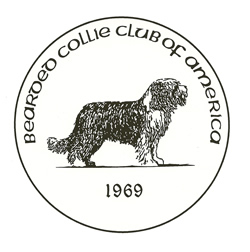“With or without white markings.” The Beardie standard offers this choice in the section on color but the truth is most Beardies come complete with white trim and those ‘without’ are as rare as snowflakes in south Florida. Some white markings may be minimal while others are far more flashy and cover as much territory as allowed by the standard (or more). Just for the record, the standard reads, “Where white occurs, it only appears on the foreface, as a blaze on the skull, on the tip of the tail, on the chest, legs and feet and around the neck.” White should not grow behind the shoulder on the body nor should it surround the eyes. Those are faults but not disqualifications.
Incidentally, I’ve typed the info about white markings the way it was originally presented. Somewhere along the way, someone moved a comma (no one has admitted to this error) so it reads, “it only appears on the foreface as a blaze, on the skull (etc.)” Apparently it means going through a standard change to put the comma in the correct place and move the blaze back to the skull where it belongs.
The white markings can go a long way to enhancing the dog’s appearance, providing contrast with the coat color. For example, a wide white collar gives the illusion of a longer neck. Conversely, unbalanced markings, such as one black front leg and one white one may fool the eye into believing the gait is ‘off.’
The catch with those markings is how to keep them white. Some Beardies are just naturally neat and clean. Ty was such a dog. She wouldn’t leave the house if it was raining. One soggy day she was entered in an obedience trial and not happy about it. Heeling along beside me, she got around the problem of getting her butt wet by sitting on my foot whenever we stopped. Other less fastidious members of the gang delighted in wallowing in mud puddles or excavating subway systems in the yard.
And it’s not just grubby paws that are the problem. The white beard can become stained by food or saliva, taking on the rosy hue of spaghetti sauce. And those paws, in addition to getting muddy, dirty or grass-stained may also succumb to saliva if your dog is trying to remove burrs or other insidious items lodged between the pads.
Obviously I’m not the only Beardie owner fighting the grubby paw syndrome. Every now and then, someone comes up with a formula guaranteed to produce snowy paws. The most obvious and simple solution is whitening shampoo. Just about every pet product manufacturer has one in its line. Some are better than others. It’s a matter of buying a small bottle and give each a try till you find one you like. Or ask friends what they prefer.
Stubborn stains require extra strength. One exhibitor swears by no-rinse shampoo followed by Faultless Blued and Perfumed Dry Starch applied with a brush to the damp paws. Give it a chance to dry and then brush it out before show time. A handler saturates damp legs and beard with baby powder and brushes it out when dry. She claims it adds a sparkle to the coat and helps to repel dirt. Along similar lines, I’ve used corn starch on damp beard and paws, letting it dry before brushing. It’s also good for making gravy.
To combat stains and stubborn dirt, a long-time exhibitor uses diluted Calgon on the legs 10 minutes prior to bathing. And after reading in Consumer Report that Tide Free was rated tops in stain removal, a couple of Beardie exhibitors gave it a try on their Beardie’s legs. They reported it didn’t completely remove the stains but reduced them by at least half.
One really strong and effective method came courtesy of a pharmacist who combines Clairol Crème Developer and Milk of Magnesia in equal parts and applies the thick mixture to the legs and beard. When dry, it should be thoroughly brushed out.
Those Beardies ‘without’ white markings are beginning to sound more appealing.
— Alice Bixler alice@bedlamkennels.com.




